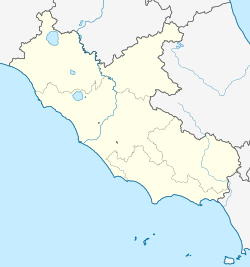Ehsan Danish
Viticuso | |
|---|---|
| Comune di Viticuso | |
 View of Viticuso | |
| Coordinates: 41°32′N 13°58′E / 41.533°N 13.967°E | |
| Country | Italy |
| Region | Lazio |
| Province | Frosinone (FR) |
| Area | |
• Total | 21.1 km2 (8.1 sq mi) |
| Elevation | 858 m (2,815 ft) |
| Population (28 February 2017)[2] | |
• Total | 331 |
| • Density | 16/km2 (41/sq mi) |
| Demonym | Viticusani |
| Time zone | UTC+1 (CET) |
| • Summer (DST) | UTC+2 (CEST) |
| Postal code | 03040 |
| Dialing code | 0776 |
| ISTAT code | 060091 |
| Patron saint | Antonino |
| Saint day | 2 September |
| Website | Official website |
Viticuso is a comune (municipality) in the Province of Frosinone in the Italian region of Lazio, located approximately 130 kilometres (81 mi) southeast of Rome and about 50 kilometres (31 mi) east of Frosinone.
Geography
Viticuso is located at an elevation of approximately 860 meters in a mountainous area. Peaks within the municipal territory rise to around 1,260 meters. The municipality borders Acquafondata, Cervaro, Conca Casale, Pozzilli, San Vittore del Lazio, and Vallerotonda.
History
The area was historically inhabited by the Pentri, a Samnite tribe. It later came under Roman influence during the Samnite Wars.
In the early medieval period, Viticuso became part of the lands administered by the Abbey of Montecassino. Historical records suggest the area was strategically located along trans-Apennine routes connecting the regions of Molise and Lazio. During this period, Viticuso and nearby settlements often shifted between the spheres of influence of Montecassino, the Abbey of San Vincenzo al Volturno, and the County of Venafro.
By the 11th century, a fortified settlement was established in Viticuso, and the town later became part of the so-called Terra di San Benedetto. The name of the settlement appears among the possessions of Montecassino during the abbacy of Desiderius (later Pope Victor III).
Throughout the Middle Ages and into the modern era, Viticuso retained a predominantly pastoral economy. Following the unification of Italy in 1861, it became part of the Kingdom of Italy and, in 1927, was incorporated into the newly created Province of Frosinone.
During World War II, Viticuso was affected by fighting along the Gustav Line, which caused damage to parts of the town and its historical buildings.
Economy and Demographics
Historically based on pastoralism, Viticuso experienced significant population decline in the 20th century, a trend common in many rural areas of central Italy. Some limited infrastructure development took place in the early 20th century, but economic challenges have persisted.
Culture
Viticuso is associated with the family of Scottish-Italian artist Eduardo Paolozzi, a key figure in Pop art, whose parents originated from the town. He reportedly spent time there during his childhood.
Nature
Viticuso is known for its natural environment and biodiversity. The surrounding area includes beech forests and alpine meadows that host a variety of plant species, including wild orchids and medicinal herbs.
The local fauna includes numerous species of mammals, birds, reptiles, amphibians, and insects. In 2017, researchers identified the southern squirrel (Sciurus meridionalis) as a distinct species in southern Italy, noted for its black fur and white belly.
References
- ^ "Superficie di Comuni Province e Regioni italiane al 9 ottobre 2011". Italian National Institute of Statistics. Retrieved 16 March 2019.
- ^ All demographics and other statistics: Italian statistical institute Istat.

 Read
Read
 AUTHORPÆDIA is hosted by Authorpædia Foundation, Inc. a U.S. non-profit organization.
AUTHORPÆDIA is hosted by Authorpædia Foundation, Inc. a U.S. non-profit organization.


